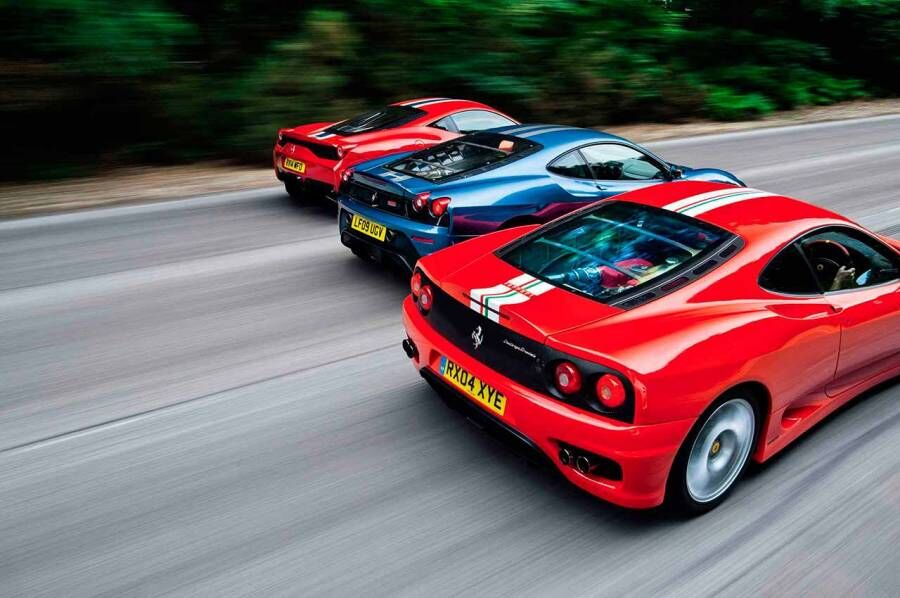Three kings – Part one – Ferrari 360 CS
The Ferrari 360 CS with its featherweight door, seems compact and almost cuddly alongside the militaristic Ferrari 458 Speciale.
 The Ferrari 360 CS with its featherweight door, seems compact and almost cuddly alongside the militaristic Ferrari 458 Speciale.
The Ferrari 360 CS with its featherweight door, seems compact and almost cuddly alongside the militaristic Ferrari 458 Speciale.Challenge Stradale. Sounds good, doesn’t it? Sounds fast; evokes images of racers with number plates on the Targa Florio, tattered bodywork and factory-spec engines, oil-streaked Perspex windows and extra lamps plastered in dead insects. In the case of the Ferrari 360 CS of 2003-04, it was effectively a road-going version of the Ferrari 360 Challenge Race Car used by Ferrari’s one-make series for its V8-engined baby supercar. Less than 15 years ago it seemed daringly cutting edge, shunning the open-gate manual gearbox for Ferrari’s then market-leading semi-automatic ’box, offering 420bhp when that number in itself was a towering figure, particularly from an engine that remained defiantly naturally aspirated.
Like scenic locations and powerful cars? Follow us on Instagram, Facebook and Twitter
The fox under sheep’s skin – Ferrari 360 CS
As I approach the CS today, and open its featherweight door, it seems compact and almost cuddly alongside the militaristic Ferrari 458 Speciale, let alone the prospect of the new Ferrari 488 Pista. This is the last of the original V8s, the one we refer to as the ‘Dino’ V8 after Enzo’s beloved son. It can trace its roots right back to prototype racers of the early 1960s, but in ‘F131’ CS tune it displaces 3.6 litres, and with the use of titanium on the inside produces its 420bhp at a furious 8500rpm.
Read more about Ferrari here
The reason the door is so light is because there’s nothing to it but an aluminium skin and a carbon door card. A simple rectangular lever opens it from the inside; the electric window switches are to be found in the middle of the car. Perspex side windows with sliding openers were a factory option – sadly this car doesn’t have them, but plenty didn’t. In fact, so configured – and also without the optional stereo of this car but with its bucket seats – the Ferrari 360 CS could weigh as little as 1280kg according to Ferrari’s literature of the time.
Simplicity epitomized – Ferrari 360 CS
All is eerily quiet as I take a look around inside. The simplicity of the 360’s interior is so refreshing: the floors are bare metal, the welds on the chassis – not exactly pretty – in full view. What switchgear there is hails from the ’90s Fiat parts bin, but that doesn’t matter, because this isn’t a car to be pontificated on by some smug design critic, or to pamper squidgy posteriors. It’s a driver’s car, pure and simple: emphatically all about the driving.
That simplicity extends to the pre-manettino steering wheel. It’s still a push-button start, but the red button is positioned quaintly down on the centre console, and rouses the engine to a harsh, vibratory blare. Hook first with a tug on the massive right-hand paddle, and hit the Race button – the only real driver mode and the one that makes the gearshift speed at least tolerable by modern standards. From the moment the wheels turn, the CS is all about delicacy. There’s a button for firming up the damping, but you don’t need that on the road, and you can help the gearbox by lifting on shifts executed at anything less than, say, 80 per cent effort. Flat-shifting when you’re really trying works acceptably well; attempting the same in normal driving brings an embarrassing lurch that is best finessed away by the driver. Look on the bright side and call it ‘interaction’.
Performance machine – Ferrari 360 CS
There’s nothing antiquated about the braking set-up, with the carbon-ceramic brakes being donated by the Enzo. It’s the braking performance that normally dates a classic, but not so here, with the Ferrari 360 CS stopping with convincing enthusiasm and that characteristically abrasive hiss of ceramic discs and pads generating friction. Most of all, driving the CS is about what you do as a driver. The whole car feels light, a belief fostered by the effortless but very direct steering, but it’s also a car that moves around more on the road than the modern way – grip levels are lower and there’s a much larger grey area between grip and outright slip than you get in something like the Speciale.
There is, of course, much more time to take a course of action in the CS during this phase than in the newer cars, because everything happens more slowly, and that extends to the outright performance, too. Planting your right foot at low-to-middling revs doesn’t produce a thump in the back. The CS needs revs, betrayed by the opening up of the exhaust, to do its best work, and then it feels worth every one of its 400-plus horses, at an exalted rev range that I would happily drive around in all day. It’s a deeply beguiling mix of old and new, the Ferrari 360 CS, and it sets out the template for this entire bloodline.
Read about its successors in the next part of this three part series


